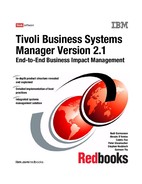
Chapter 11. z/OS data feeds and discovery 385
11.9 System Managed Storage (SMS)
This section describes the configuration steps for SMS data source integration
into IBM Tivoli Business Systems Manager.
11.9.1 Concept
The conceptual flow is shown in Figure 11-27.
Figure 11-27 SMS information flow
Disk devices and their resources are collected regularly by a set of batch jobs.
The results are transferred using the MVS IP listener and loaded to the IBM Tivoli
Business Systems Manager database by a set of jobs that are scheduled by the
SQL Server Agent.
11.9.2 Integration setup
Several things must be set up for DFSMS resources:
? “Configuring the z/OS components” on page 385
? “Configuring the TBSM server” on page 386
Configuring the z/OS components
Perform the following in the z/OS:
? Configure the JCLs members in hlq.SGTMSAMP shown in Table 11-1 on
page 386 and run in the designated order to collect and transmit the
SMS-managed resource data to the IBM Tivoli Business Systems Manager
database. These jobs may be scheduled to run daily.
SQL Server Agent jobs
SMS Disk Device Discovery
SMS Disk Volume and Storage Group Discovery
SMS Data Set Discovery
SMS Catalog Entry Discovery
GTMDCLBD
GTMUCBBD
GTMCATBD
GTMVTCBD
TBSM MVS IP Listener

386 Tivoli Business Systems Manager Version 2.1: End-to-End Business Impact Management
Table 11-1 TBSM batch jobs for SMS
? Ensure that the RMF is active and is collecting SMF type 74 records to an
SMF buffer. It is recommended to have a buffer of 8M for SMF record 74
collection.
Configuring the TBSM server
This section describes the steps required on the IBM Tivoli Business Systems
Manager server environment to enable DFSMS integration.
1. Enable and schedule the following SQL server jobs on the database server:
– SMS Disk Device Discovery Load
– SMS Disk Device Discovery Process
– SMS Disk Volume and Storage Group Discovery Load
– SMS Disk Volume and Storage Group Discovery Process
– SMS Data Set Discovery Load
– SMS Data Set Discovery Process
– SMS Catalog Entry Discovery Load
– SMS Catalog Entry Discovery Process
2. Enable monitoring. To assign the default threshold profiles for space usage
exceptions, device performance exceptions, and cache performance
exceptions, you must perform the following steps.
a. Create a copy of smssampleintervalprofiles.sqi called
smsintervalprofiles.sqi in the TivoliManager/sql directory.
b. Compile your copy of the smsintervalprofiles.sqi file with this command
syntax:
clsql smsintervalprofiles.sqi
c. Apply the compiled file to the database using this command syntax:
isql -S ibmtiv5 -U sa -P XXXX -i smsintervalprofiles.sql
Optionally, you may customize the threshold profiles.
Member name Resources Recommended parameter
GTMDCLBD Storage Group,Disk Volume * (all volumes)
GTMUCBBD Disk Device ALL
GTMCATBD Catalog entry ALL
GTMVTCBD data set ALLVTOCS
..................Content has been hidden....................
You can't read the all page of ebook, please click here login for view all page.

